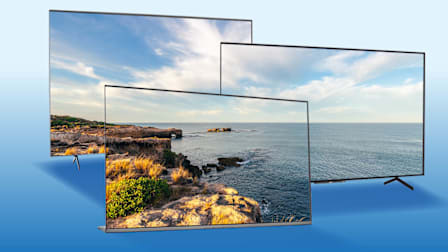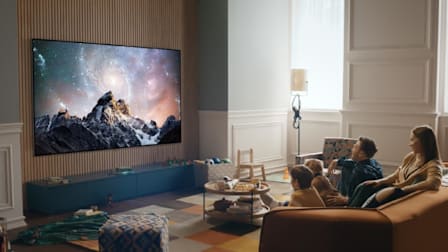The TVs Coming From Hisense, LG, Roku, Samsung, Sharp, Sony, and TCL in 2023
This year you'll see brighter OLED TVs, more LCD sets with Mini LED backlights, and huge TV screens closing in on 100 inches
Just days into the new year, we already have a good idea of what TV shoppers can expect in 2023. It starts with more LCD sets that use Mini LEDs in their backlights; some developments to boost brightness in OLED TVs, which traditionally have topped our TV ratings; and more TV brands offering sets with screens 85 inches and even larger.
Just like last year, all the top TV brands are touting impressive gaming performance, with features such as faster variable refresh rates (VRR) and auto gaming settings that automatically put the TV into low-latency game modes.
One oddity at the Consumer Electronics Show (CES), held in Las Vegas in early January, was that Sony didn’t make any announcements about TVs or soundbars, instead focusing on its PlayStation VR2 headset, a “Gran Turismo” movie and virtual reality game, and a new electric car it’s jointly developing with Honda.
Last year, perhaps the biggest TV announcements at the show were about sets made with a new OLED TV technology—called QD OLED—by Samsung and Sony. We tested several QD OLED TVs last year, and they are among the highest-rated sets in our TV ratings, with very bright, colorful images, and impressive HDR (high dynamic range) performance.
Hisense
As it did in 2022, this year Hisense is splitting its focus between conventional TVs and its growing business in short-throw laser projectors.
In its main TV business, Hisense continues to focus on its “ULED” TVs, the name it gives its higher-end sets that use quantum dots to produce a very wide range of colors. Perhaps the biggest news for most consumers looking for a TV is that Hisense will include Mini LEDs in all of its ULED TVs this year. Other brands are reserving Mini LEDs just for their midlevel and top-tier sets.
The company is also doubling down on jumbo screen sizes, offering five new 85-inch sets in 2023, up from just two last year.
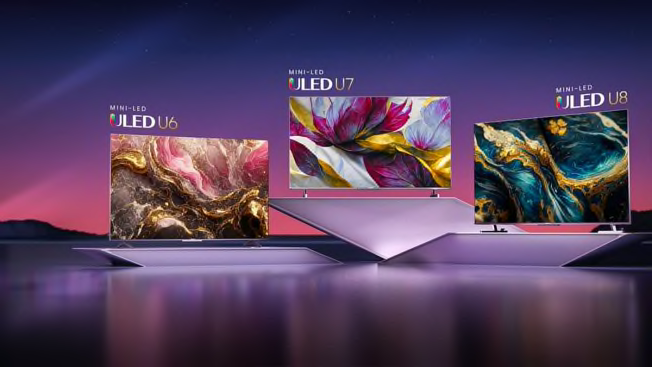
Photo: Hisense Photo: Hisense
This year, Hisense will have three mainstream ULED TV series, plus a new flagship model, ULED X (details below). All ULED sets use the Google TV smart TV system. Other models are either Roku TVs or come with Hisense’s own VIDAA smart TV platform.
The new entry-level ULED series will be the U6K sets, offered in screen sizes ranging from 50 to 85 inches. Hisense says the 50-inch set will be priced under $500 and will support both Dolby Vision and HDR10+ (those are both HDR standards), as well as Dolby Atmos audio. The TVs will have more local dimming zones than last year’s models and up to 600 nits of peak brightness, also an improvement.
Stepping up to the U7K series sets, which the company targets toward gamers, will get you higher peak brightness—up to 1,000 nits—and more than 500 local dimming zones. Other features include 144Hz variable refresh rates, an auto low-latency mode, and a special Gaming Bar game-status feature that was available only on the U8H models last year. The sets will be offered in 55- to 85-inch screen sizes.
Last year, Hisense’s U8H-series sets did very well in our ratings, offering very satisfying overall picture quality and very good to excellent HDR performance, especially for the price. In 2023, the replacement U8K sets could be even better because they’re doubling the amount of local dimming zones (to over 1,000) and hitting peak brightness levels of up to 1,500 nits. The TVs also have 144Hz VRR, support for the new WiFi6e wireless standard, and a 2.1.2-channel Dolby Atmos sound system with a built-in subwoofer and upfiring speakers.
Hisense will also offer a range of even lower-priced non-ULED sets in its A65K series, which will come in screen sizes from 43 to 75 inches. All but the least expensive sets come with ATSC 3.0 tuners for receiving Next-Gen TV over-the-air signals, which will be rolling out across the U.S. in the next few years.
The new “ultimate” LCD/LED TV, ULED X, comes with some major claims in both brightness—up to 2,500 nits—and state-of-the-art Mini LED technology, with over 20,000 Mini LED lights and more than 5,000 local dimming zones. It has a new AI processor, along with a 16-bit “light control” algorithm, which is supposed to provide more precise control over local dimming zones. The set includes a newly developed “CineStage X” 4.1.2-channel Dolby Atmos audio system. The first set will be available only in an 85-inch screen size; price and availability weren’t disclosed.
Hisense is also expanding its line of Laser TVs, which are short-throw front projectors that can be placed very close to a wall or screen. CR doesn’t usually cover projectors, but we will revisit the category when pricing is revealed. Historically they’ve been much more expensive than conventional TVs.
LG Electronics
LG will manage a now-familiar balancing act, touting improved performance in its LCD lineup while continuing to promote its OLED TVs as the pinnacle of TV performance. But at CES it was clear that OLED TVs are occupying the bulk of the company’s TV attention, with some interesting new designs.
This year the company will offer a giant, completely wireless OLED TV that gets signals beamed from a separate control box. The company will also have a new flexible OLED TV that can bend into a curve for use as a gaming monitor. More on both in a bit.
Like last year, the company’s flagship TVs will be pricey Z-series (Z3) 8K OLED sets, offered in 77- and 88-inch screen sizes. As in the past, the most advanced 4K OLED tech will go into the company’s design-focused Gallery, or G-series, sets. However, LG’s C3 series lineup, which has typically offered the best bang for the buck of any LG OLED TVs, also gets many improvements.
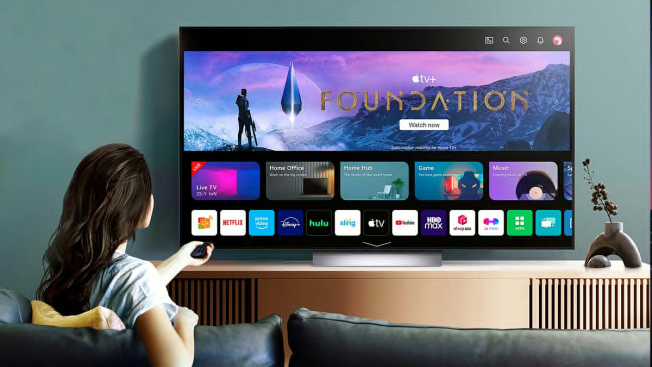
Photo: LG Photo: LG
Once again, both the G3 and C2 sets get the high-performing Evo OLED panels and the company’s most advanced AI processors, which help up-convert lower-resolution content. These panels use a new algorithm and light-control architecture to boost brightness by up to 70 percent in the G3 sets, which can hit 1,800 nits, the company says. The G3 sets have an additional brightness booster feature the C3 sets lack. Last year, both sets were among the best TVs we tested.
There will also be a new lower-priced B3-series series, but the company is discontinuing last year’s entry-level A-series lineup.
Other features include an updated webOS smart TV interface that has a new Quick Settings feature, which lets you access the most used settings without having to actually go into Settings, and Quick Cards, which lets you call up content based on categories such as home office, games, sports, and music.
Consumers will also have more options for personalization, including Al Concierge, which allows each user profile to receive its own curated list of content choices based on past usage and searches. Another unique feature, called AI Picture Wizard, is somewhat akin to a visit to an optometrist. It shows you several picture scenes and asks you which ones you like better, eventually coming up with a custom picture setting that reflects your taste.
LG didn’t have a lot to say about its LCD/LED TV lineup, which we assume will be revealed closer to launch, but this year only the top-tier QNED 85-series models, in 55- to 86-inch screen sizes, get Mini LED backlights. (The QNED80- and QNED75-series sets will have more conventional local dimming.)
Most LG customers will get one of these more conventional TVs, but the two new TV types mentioned earlier were really eye-catching at the show. The flexible 42-inch OLED TV, called OLED Flex, can be bent into a curve using the remote for immersive gaming or kept flat for TVs and movies. It has 20 different levels of curvature. This set is actually available now, for about $2,500, obviously quite expensive for a TV this size.
For those who dream a bit bigger, LG will have a 97-inch wireless OLED TV that can send 4K 120Hz video and audio to the TV using proprietary wireless technology. Called the Signature OLED M TV, it comes with a Zero Connect box that houses all the connections, sending signals to the TV without wires from up to 30 feet away. In a demo we saw, the signal wasn’t disrupted when someone walked between the box and the TV set.
Roku
Perhaps feeling the heat from other licensed smart TV platforms such as Amazon Fire TV and Google TV, which are attracting new partners, Roku will offer its first Roku-branded TVs in the U.S. this spring.
Roku says any new features or innovations that debut on its own sets will be made available to its partners in the Roku TV program.
The company also announced its first reference design for OLED TVs for any manufacturers wanting to offer OLED TVs with the Roku TV smart system baked in. No companies were named but TCL, which is a Roku TV licensee. It announced it would offer its first OLED TV in 2023.
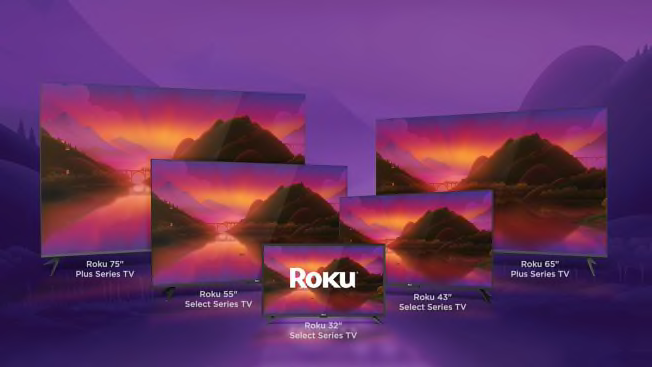
Photo: Roku Photo: Roku
In all, there will be 11 Roku TV models in a pair of series: Roku Select and Roku Plus. Screen sizes will range from 24 to 75 inches. Prices go from $119 up to $999, according to the company.
The main differences between the two series are the remote controls. All Select Series TVs come with a Roku Voice Remote with push-to-talk controls, while all Plus Series TVs include the Roku Voice Remote Pro, featuring hands-free voice commands.
Roku says that all Roku-branded TVs will have an expanded audio ecosystem that can make use of a Roku TV Wireless Soundbar, which will be released this spring.
Samsung
Samsung brought big-news firepower to CES last year with the industry’s first QD OLED TV, which performed very well in CR’s ratings. In 2023, Samsung’s TV lineup is about iterative improvements to make those sets even better. This year Samsung will again have a very diverse array of TV products, including a new, smaller Micro LED “Wall TV,” new flagship 8K and 4K Neo QLED TVs that use Mini LED backlights, and a new 77-inch QD OLED TV screen size.
I’ve put together a deep dive into QD OLED technology, but in short here’s why QD OLED is such a big deal. Basically, it marries the traditional benefits of OLED TVs—rich, deep blacks, high contrast, and unlimited viewing angles—with quantum dots, which can produce a wider range of more vibrant colors. Because these TVs don’t use color filters in front of the light source, QD-OLED TVs have the potential to reach higher peak brightness levels without losing any contrast. (If OLED TVs in the past had a weakness, it was their relatively low peak brightness.)
Last year, Samsung’s biggest QD OLED set was 65 inches, but in 2023 the company will offer 77-inch models in both its flagship S95C series, which replaces last year’s S95B sets, and a new S90C series. Samsung says the TVs will be even brighter than last year’s models, with more vibrant colors and improved HDR performance. They’ll also include a new “Auto HDR Remastering” feature, which can analyze and apply HDR effects to SDR content.
All the S95C sets will have upfiring speakers and support for 4.2.2 Dolby Atmos sound and come with the external One Connect box for connections. The S90C models are similar, though they lack the One Connect box and have a slightly less premium audio system. Both have 144Hz refresh rates and Samsung’s Gaming Hub for gamers.
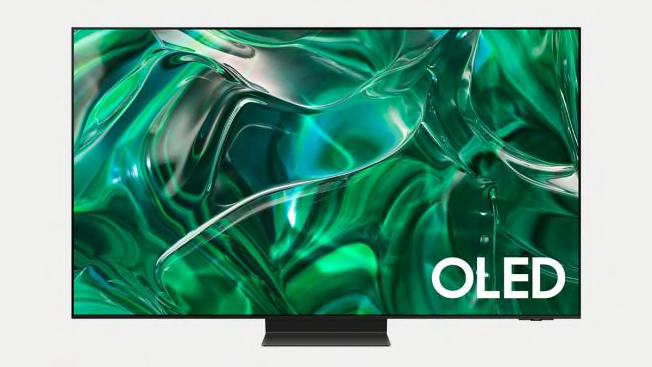
Photo: Samsung Photo: Samsung
Of course, Samsung is also making improvements to its top-tier Neo QLED TVs, which are quantum dot sets that use Mini LED backlights. Without getting too technical, Samsung says it’s improving brightness and contrast by increasing the number of dimming zones in the Mini LED backlight, with better algorithms for controlling them.
In terms of 8K, the flagship series will be the QN900C series, which boasts up to 4,000 nits of brightness and up to 1,000 local dimming zones that can offer near-OLED black levels, the company claims. These sets have an ultra-thin frame design with hidden speakers. There’s also a QN800C series below it with fewer features.
Samsung’s top 2023 Neo QLED models get the new “Neural Quantum” processor found in the QD OLED sets, which supports 14-bit processing and AI upscaling. There’s also a new Auto HDR Remastering feature, which the company says can apply HDR effects to standard dynamic range content to produce brighter, more dynamic images.
The flagship 4K Neo QLED series will be the QN95C models, which do away with last year’s One Connect box and come with a detachable webcam for video conferencing, fitness, and telehealth monitoring services.
Among the new software features—and there are a lot of them, ranging from telehealth and in-home health monitoring to the ability to chat in real time on your TV—is one called Relumino Mode. This is designed to help those with limited vision enjoy TV shows. Enabled by a click on the remote, the mode uses AI to dynamically outline the edges of onscreen elements and rebalance colors to make people, objects, and even text easier to see.
Finally, Samsung has been promoting MicroLED display tech for several years now. It’s basically the LED equivalent of an OLED TV, where every tiny LED pixel generates its own light, with no need for a separate backlight. MicroLED TVs have tended to be huge (starting at 110 inches), expensive, and somewhat limited in resolution at smaller sizes.
However, Samsung says this year you’ll be able to buy a new 76-inch MicroLED CX. Although the company promises it will be the most affordable MicroLED TV ever released, it didn’t disclose how much the set will actually cost or when you can actually buy it.
The eventual MicroLED lineup will range from 50 to 140 inches, the company says. To date, MicroLED TVs have been interesting but prohibitively expensive for most consumers, so we’ll have to see how much the company will charge for the MicroLED CX when it’s released.
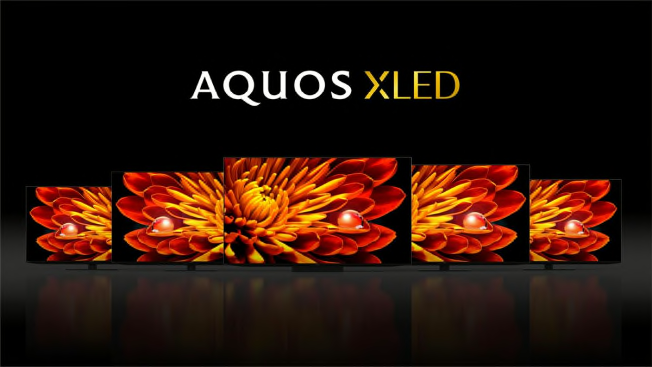
Photo: Sharp Photo: Sharp
In addition to the XLED Mini LED sets, Sharp will also have both LCD/LED and OLED TVs that use the Roku smart TV system. So far, no information has been released about the LCD/LED sets other than that they’ll be offered in 50-, 55-, 65-, and 75-inch screen sizes.
Sharp also says it will have 4K OLED TVs in 55- and 65-inch screen sizes this year, using Roku’s new OLED TV reference design, which is being offered to all Roku TV partners. In addition to including the Roku smart TV system, these sets will include gaming features such as support for 4K 120Hz variable refresh rates and auto low-latency game modes.
Sony
Based on its CES press conference, you might wonder whether Sony is still in the consumer electronics business apart from its PlayStation 5 game console. Breaking with tradition, it didn’t share any information about its 2023 Bravia TV lineup and instead focused on a new “Gran Turismo” movie from Sony Pictures that will make its way as a game to the new PlayStation VR2 virtual reality headset, and a new controller designed to make gaming easier for those with disabilities.
Sony also used the show to present a prototype of a new electric car brand, Afeela, which is being developed as part of a joint venture with Honda, called Sony Honda Mobility. The new vehicle, which includes 45 cameras and sensors inside and outside the car, will start production in 2025, with the first shipments in the U.S. expected in the spring of 2026.
Last year Sony’s biggest TV news was a new flagship A95K QD-OLED TV, which turned out to be one of the best TVs we tested in 2022. We’ll probably have to wait another month to hear details about Sony’s 2023 TV lineup. But we expect the company to offer an updated version of that set, perhaps in a new 77-inch screen size, as well as newer versions of its A90K and A80K regular OLED TV series.
We also expect Sony to update its Cognitive Processor, which is found in the company’s higher-end models. It attempts to determine how people perceive images, adjusts the picture to make it look more natural and realistic by dividing the screen into numerous zones, then enhances the specific areas where it believes a typical viewer will be focusing their attention, such as faces. The processing also matches audio to what’s on the screen and upconverts it to 3D surround sound.
As for Sony’s LCD/LED TV Lineup, last year the two top series—the Z9K and X95K—got Mini LED backlights plus Backlight Master Drive technology Sony claims can offer more control over the Mini LEDs than conventional methods. We’ll have to wait to see if Sony rolls out Mini LED backlights in more models in 2023.
Last year some top models came with a bundled webcam, called the Bravia Cam, which attaches to the TV magnetically. (It has a shutter you can close when you want to make sure it’s not watching.) Some also touted a Roku-like remote finder feature plus improved gaming features, including automatic HDR tone mapping for PlayStation 5.
We’ll let you know more about Sony’s 2023 TV lineup once those details are released.
TCL
Like Hisense, TCL has been an up-and-coming brand in the U.S. for the past few years, and several of its 6-series TVs have done very well in our ratings, especially for their price. In 2023 the company is rejiggering its TV lineup, with a new flagship series bearing the QM8 moniker. Like last year’s R6-series sets, it will use Mini LED backlights, and you’ll be able to get it only in larger screen sizes, starting at 65 inches and going all the way up to a 98-inch behemoth.
Perhaps the biggest surprise, though, was that TCL announced plans to introduce QD-OLED TVs into its TV lineup this year, though few details were released. It also says it’s making its move into the custom installation market this year.
In 2023, TCL’s TV lineup will be split into two distinct families: lower-priced mainstream S-series models and step-up Q-series sets. All will get a new bezel-less design, plus updated gaming features.
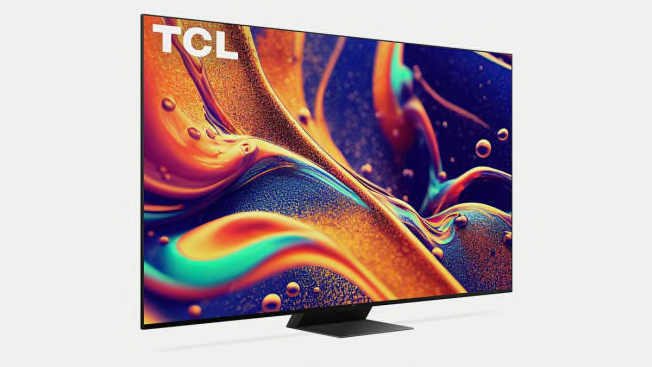
Photo: TCL Photo: TCL
The new Q series will focus on bigger and better QLED models, starting with the Q6 sets, which will be brighter than last year’s entry-level QLED models. Available in screen sizes from 50 to 75 inches, these will be 60Hz sets that feature 120Hz processing (called Game Accelerator 120) for VRR gaming. Stepping up to the Q7 sets gets you higher peak brightness, more local dimming zones than last year’s QLED sets, and a native 120Hz panel, with up to 240Hz Game Accelerator VRR. The sets, which feature IMAX Enhanced certification for the first time, will be available in 55- to 85-inch screen sizes.
Topping TCL’s 2023 TV lineup will be the QM8-series sets. This year they’ll be the only sets with Mini LED backlights, with up to 2,300 local dimming zones, five times what the company offered in last year’s Mini LED sets. The TVs, which boast twice the peak brightness of last year’s sets, will also feature a built-in subwoofer and support for the newer WiFi 6 wireless standard.
More budget-minded consumers can choose from two S-series lines. The S3 sets are 1080p models, while the S4 TVs are entry-level 4K sets that support Dolby Vision HDR and Dolby Atmos audio. TCL’s S3 model will be available in 32- to 43-inch screen sizes, while the S4 will be offered in 43- to 85-inch screen sizes.
TCL will continue to offer the 98-inch R98 4K set, which gets improved with all the features found on the QM models, including Mini LED backlights. The current model is selling for about $8,500 at a few retailers.
TCL told us it will continue to support both Google TV and Roku smart TV systems this year. We’ll have more information about specific model names and pricing closer to launch starting in the second quarter of 2023.





























